Biodegradable Hydrogenated Dimer Acid-Based Plasticizers for PLA with Excellent Plasticization, Thermal Stability and Gas Resistance
Abstract
:1. Introduction
2. Results
2.1. Structural Characterizations
2.2. Mechanical Properties and Low-Temperature Resistance of Plasticized PLA Samples
2.3. XRD Spectra Analysis
2.4. Surface Analysis of Plasticized PLA Samples
2.5. Thermal Stability and Migration Resistance of Plasticized PLA
2.6. Volatility Test of Plasticized PLA
2.7. Water Vapor Transmittance Rate (WVTR) and Oxygen Permeability (OP)
2.8. Biodegradation Test of Plasticized PLA
3. Materials and Methods
3.1. Materials
3.2. Synthesis of Hydrogenated Dimer Acid-based Polyethylene Glycol Methyl Ether Ester
3.3. Preparation of PLA Samples
3.4. Characterization
4. Conclusions
Supplementary Materials
Author Contributions
Funding
Institutional Review Board Statement
Informed Consent Statement
Data Availability Statement
Conflicts of Interest
References
- Auras, R.A.; Singh, S.P.; Singh, J.J. Evaluation of oriented poly(lactide) polymers vs. Existing pet and oriented ps for fresh food service containers. Packag. Technol. Sci. 2005, 18, 207–216. [Google Scholar] [CrossRef]
- Bae, G.Y.; Jang, J.; Jeong, Y.G.; Lyoo, W.S.; Min, B.G. Superhydrophobic pla fabrics prepared by uv photo-grafting of hydrophobic silica particles possessing vinyl groups. J. Colloid Interface Sci. 2010, 344, 584–587. [Google Scholar] [CrossRef] [PubMed]
- Gupta, B.; Revagade, N.; Hilborn, J. Poly(lactic acid) fiber: An overview. Prog. Polym. Sci. 2007, 32, 455–482. [Google Scholar] [CrossRef]
- Rojanapitayakorn, P.; Thongyai, S.; Higgins, J.S.; Clarke, N. Effects of sample preparation method on mixing and phase separation in binary polymer blends. Polymer 2001, 42, 3475–3487. [Google Scholar] [CrossRef]
- Meng, X.; Nguyen, N.A.; Tekinalp, H.; Lara-Curzio, E.; Ozcan, S. Supertough pla-silane nanohybrids by in situ condensation and grafting. ACS Sustain. Chem. Eng. 2018, 6, 1289–1298. [Google Scholar] [CrossRef]
- Jiang, L.; Wolcott, M.P.; Zhang, J. Study of biodegradable polylactide/poly(butylene adipate-co-terephthalate) blends. Biomacromolecules 2006, 7, 199–207. [Google Scholar] [CrossRef] [PubMed]
- Choi, K.; Choi, M.; Han, D.; Park, T.; Ha, C. Plasticization of poly(lactic acid) (pla) through chemical grafting of poly(ethylene glycol) (peg) via in situ reactive blending. Eur. Polym. J. 2013, 49, 2356–2364. [Google Scholar] [CrossRef]
- Guo, Z.H.; Zhang, S.; Liang, Y.; Zhang, H.H.; Qian, X.Q.; Qian, S.P.; Sheng, K. Toughness enhancement of poly(lactic acid), bamboo particle and ultrafine bamboo-char ternary biocomposites by polyethylene glycol plasticization. J. Polym. Environ. 2022, 30, 1162–1169. [Google Scholar] [CrossRef]
- Xie, D.; Zhao, Y.; Li, Y.; Lachance, A.M.; Lai, J.Q.; Sun, L.Y.; Chen, J.J. Rheological, thermal, and degradation properties of pla/ppg blends. Materials 2019, 12, 3519. [Google Scholar] [CrossRef]
- Yang, S.; Wu, Z.; Meng, B.; Yang, W. The effects of dioctyl phthalate plasticization on the morphology and thermal, mechanical, and rheological properties of chemical crosslinked polylactide. J. Polym. Sci. Part B Polym. Phys. 2009, 47, 1136–1145. [Google Scholar] [CrossRef]
- Wang, X.; Song, L.; Zhou, X. Improved performance of poly(lactic acid) nanocomposites with poly(butyl acrylate)-modified cellulose nanowhiskers. Polym. Compos. 2023, 44, 7533–7544. [Google Scholar] [CrossRef]
- Kusumaningtyas, R.D.; Prasetiawan, H.; Anggraeni, N.D.; Anisa, E.; Hartanto, D. Conversion of free fatty acid in calophyllum inophyllum oil to fatty acid ester as precursor of bio-based epoxy plasticizer via sncl2-catalyzed esterification. Polymers 2023, 15, 123. [Google Scholar] [CrossRef] [PubMed]
- Darie-Nita, R.N.; Vasile, C.; Irimia, A.; Lipsa, R.; Rapa, M. Evaluation of some eco-friendly plasticizers for pla films processing. J. Appl. Polym. Sci. 2016, 133, 43223. [Google Scholar] [CrossRef]
- Pan, S.Y.; Hou, D.L.; Chang, J.M.; Xu, Z.; Wang, S.H.; Yan, S.X.; Zeng, Q.; Wang, Z.H.; Chen, Y. A potentially general approach to aliphatic ester-derived pvc plasticizers with suppressed migration as sustainable alternatives to dehp. Green Chem. 2019, 21, 6430–6440. [Google Scholar] [CrossRef]
- Quiles-Carrillo, L.; Duart, S.; Montanes, N.; Torres-Giner, S.; Balart, R. Enhancement of the mechanical and thermal properties of injection-molded polylactide parts by the addition of acrylated epoxidized soybean oil. Mater. Des. 2018, 140, 54–63. [Google Scholar] [CrossRef]
- Miao, S.; Wang, P.; Su, Z.; Zhang, S. Vegetable-oil-based polymers as future polymeric biomaterials. Acta Biomater. 2014, 10, 1692–1704. [Google Scholar] [CrossRef]
- Zhang, Z.; Jiang, P.; Liu, D.; Feng, S.; Zhang, P.; Wang, Y.; Fu, J.; Agus, H. Research progress of novel bio-based plasticizers and their applications in poly(vinyl chloride). J. Mater. Sci. 2021, 56, 10155–10182. [Google Scholar] [CrossRef]
- Lee, S.; Ko, K.; Shin, J.; Kim, N.; Kim, Y.; Kim, J. Effects of the addition of dimer acid alkyl esters on the properties of ethyl cellulose. Carbohydr. Polym. 2015, 121, 284–294. [Google Scholar] [CrossRef] [PubMed]
- Tan, J.; Liu, B.; Fu, Q.; Wang, L.; Xin, J.; Zhu, X. Role of the oxethyl unit in the structure of vegetable oil-based plasticizer for pvc: An efficient strategy to enhance compatibility and plasticization. Polymers 2019, 11, 779. [Google Scholar] [CrossRef]
- Tan, J.; Fu, Q.; Qu, Y.; Wang, F.; Wang, W.; Wang, F.; Cao, Y.; Zhu, X. Direct transformation of fatty acid-derived monomers from dimer acid manufacturing into valuable bio-plasticizers with high plasticization and compatibilization. J. Clean Prod. 2021, 289, 125821. [Google Scholar] [CrossRef]
- Feng, G.D.; Hu, L.H.; Ma, Y.; Jia, P.Y.; Hu, Y.; Zhang, M.; Liu, C.G.; Zhou, Y.H. An efficient bio-based plasticizer for poly (vinyl chloride) from waste cooking oil and citric acid: Synthesis and evaluation in pvc films. J. Clean Prod. 2018, 189, 334–343. [Google Scholar] [CrossRef]
- Liu, H.; Chen, N.; Shan, P.; Song, P.; Liu, X.; Chen, J. Toward fully bio-based and supertough pla blends via in situ formation of cross-linked biopolyamide continuity network. Macromolecules 2019, 52, 8415–8429. [Google Scholar] [CrossRef]
- Carbonell-Verdu, A.; Samper, M.D.; Garcia-Garcia, D.; Sanchez-Nacher, L.; Balart, R. Plasticization effect of epoxidized cottonseed oil (ecso) on poly(lactic acid). Ind. Crops Prod. 2017, 104, 278–286. [Google Scholar] [CrossRef]
- Niu, W.; Guo, Y.; Huang, W.; Song, L.; Xiao, Z.; Xie, Y.; Wang, Y. Aliphatic chains grafted cellulose nanocrystals with core-corona structures for efficient toughening of pla composites. Carbohydr. Polym. 2022, 285, 119200. [Google Scholar] [CrossRef] [PubMed]
- Tan, J.; Lu, T.; Li, R.; Zhang, S.; Liu, W.; Zhu, X.; Zhang, J.; Xin, J. Biodegradable waste frying oil-based ethoxylated esters as highly efficient plasticizers for poly(lactic acid). ACS Sustain. Chem. Eng. 2019, 7, 15957–15965. [Google Scholar] [CrossRef]
- Tan, J.; Zhang, S.; Lu, T.; Li, R.; Zhong, T.; Zhu, X. Design and synthesis of ethoxylated esters derived from waste frying oil as anti-ultraviolet and efficient primary plasticizers for poly(vinyl chloride). J. Clean Prod. 2019, 229, 1274–1282. [Google Scholar] [CrossRef]
- Chieng, B.W.; Ibrahim, N.A.; Then, Y.Y.; Loo, Y.Y. Mechanical, thermal, and morphology properties of poly(lactic acid) plasticized with poly(ethylene glycol) and epoxidized palm oil hybrid plasticizer. Polym. Eng. Sci. 2016, 56, 1169–1174. [Google Scholar] [CrossRef]
- Enumo, A.; Gross, I.P.; Saatkamp, R.H.; Pires, A.T.N.; Parize, A.L. Evaluation of mechanical, thermal and morphological properties of pla films plasticized with maleic acid and its propyl ester derivatives. Polym. Test 2020, 88, 106552. [Google Scholar] [CrossRef]
- Yang, Y.; Xiong, Z.; Zhang, L.; Tang, Z.; Zhang, R.; Zhu, J. Isosorbide dioctoate as a “green” plasticizer for poly(lactic acid). Mater. Des. 2016, 91, 262–268. [Google Scholar] [CrossRef]
- Halloran, M.W.; Danielczak, L.; Nicell, J.A.; Leask, R.L.; Marić, M. Highly flexible polylactide food packaging plasticized with nontoxic, biosourced glycerol plasticizers. ACS Appl. Polym. Mater. 2022, 4, 3608–3617. [Google Scholar] [CrossRef]
- Park, M.; Choi, I.; Lee, S.; Hong, S.; Kim, A.; Shin, J.; Kang, H.; Kim, Y. Renewable malic acid-based plasticizers for both pvc and pla polymers. J. Ind. Eng. Chem. 2020, 88, 148–158. [Google Scholar] [CrossRef]
- Yalcinkaya, E.E.; Puglia, D.; Fortunati, E.; Bertoglio, F.; Bruni, G.; Visai, L.; Kenny, J.M. Cellulose nanocrystals as templates for cetyltrimethylammonium bromide mediated synthesis of ag nanoparticles and their novel use in pla films. Carbohydr. Polym. 2017, 157, 1557–1567. [Google Scholar] [CrossRef] [PubMed]
- Zhang, K.; Nagarajan, V.; Misra, M.; Mohanty, A.K. Supertoughened renewable pla reactive multiphase blends system: Phase morphology and performance. ACS Appl. Mater. Interfaces 2014, 6, 12436–12448. [Google Scholar] [CrossRef] [PubMed]
- Tan, J.; Huang, N.; Wu, J.; Xu, M.; Wang, W.; Wang, X.; Zhu, X. Synthesis of gallic acid-derived plasticizers for polyvinyl chloride featuring excellent plasticization, thermo-stability, and migration resistance. ACS Appl. Polym. Mater. 2023, 5, 8608–8617. [Google Scholar] [CrossRef]
- Hassouna, F.; Raquez, J.; Addiego, F.; Toniazzo, V.; Dubois, P.; Ruch, D. New development on plasticized poly(lactide): Chemical grafting of citrate on pla by reactive extrusion. Eur. Polym. J. 2012, 48, 404–415. [Google Scholar] [CrossRef]
- Vyazovkin, S. Kissinger method in kinetics of materials: Things to beware and be aware of. Molecules 2020, 25, 2813. [Google Scholar] [CrossRef]
- Zhang, Z.; Jiang, P.; Wai, P.T.; Feng, S.; Lu, M.; Zhang, P.; Leng, Y.; Pan, L.; Pan, J. Construction and synthesis of high-stability biobased oligomeric lactate plasticizer: Applicable to pvc and pla polymers. Ind. Eng. Chem. Res. 2022, 61, 12931–12941. [Google Scholar] [CrossRef]
- Hu, Y.; Bei, Y.; Bo, C.; Hu, F.; Hu, L.; Zhou, Y.; Jia, P. Biodegradable plasticizer from cardanol via acid-free catalysis of quaternary ammonium phosphotungstate. ACS Sustain. Chem. Eng. 2023, 11, 1690–1700. [Google Scholar] [CrossRef]
- Swetha, T.A.; Bora, A.; Mohanrasu, K.; Balaji, P.; Raja, R.; Ponnuchamy, K.; Muthusamy, G.; Arun, A. A comprehensive review on polylactic acid (pla)–synthesis, processing and application in food packaging. Int. J. Biol. Macromol. 2023, 234, 123715. [Google Scholar] [CrossRef]
- Thuy, V.T.T.; Hao, L.T.; Jeon, H.; Koo, J.M.; Park, J.; Lee, E.S.; Hwang, S.Y.; Choi, S.; Park, J.; Oh, D.X. Sustainable, self-cleaning, transparent, and moisture/oxygen-barrier coating films for food packaging. Green Chem. 2021, 23, 2658–2667. [Google Scholar] [CrossRef]
- Leonard, E.C. Polymerization-dimer acids. J. Am. Oil Chem. Soc. 1979, 56, 782A–785A. [Google Scholar] [CrossRef]
- GB/T1040.3-2006; Plastics–Determination of Tensile Properties–Part 3: Test Conditions for Films and Sheets. China Standards Press: Beijing, China, 2006.
- GB/T 19789-2021; Packaging Material–Test Method Foroxygen Gas Permeability Characteristics of Plastic Film and Sheeting–Coulometrie Sensor. China Standards Press: Beijing, China, 2021.
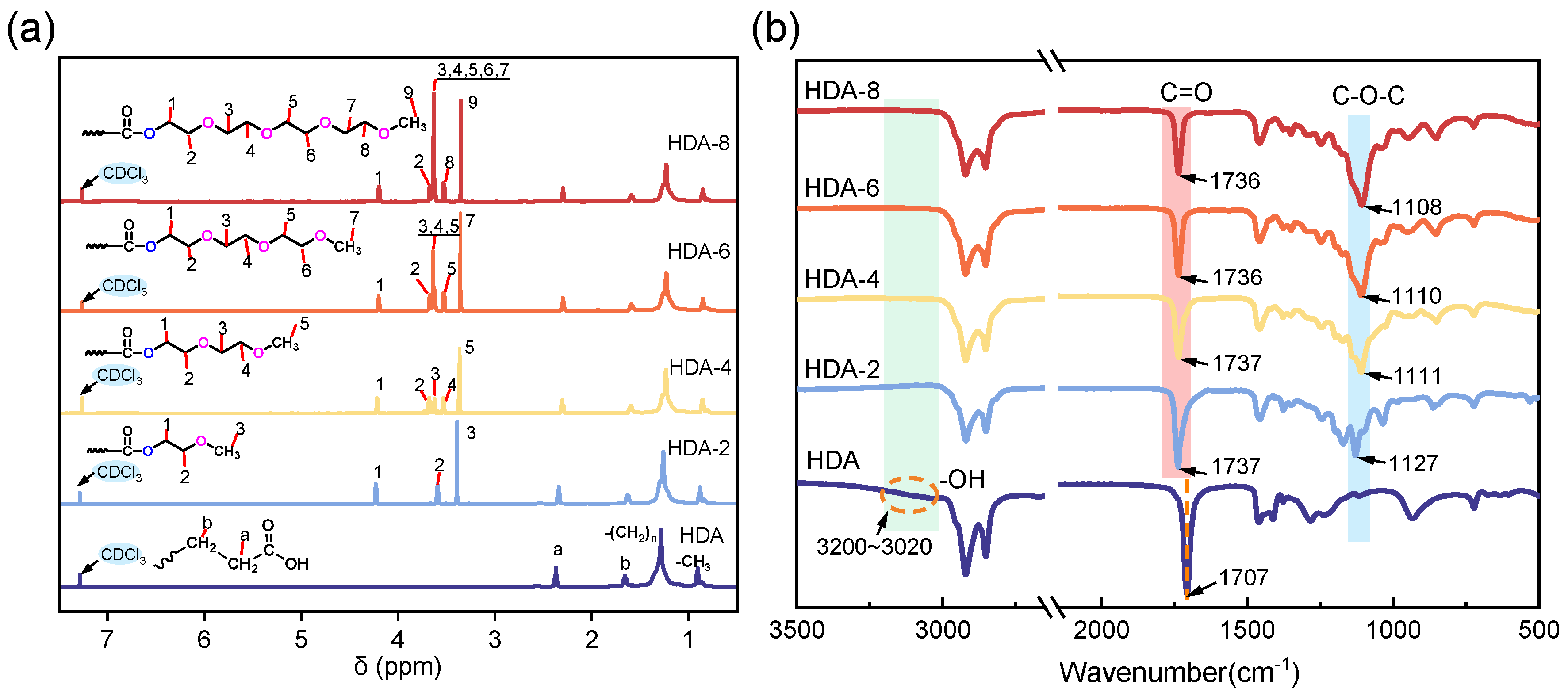


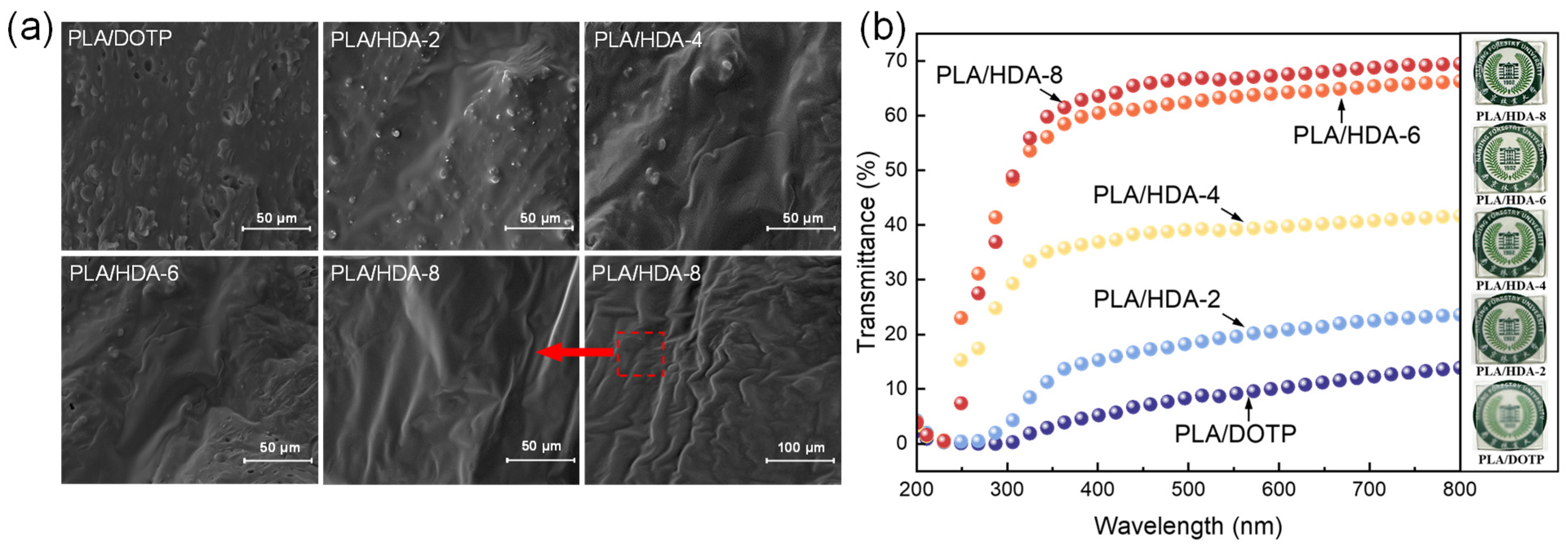


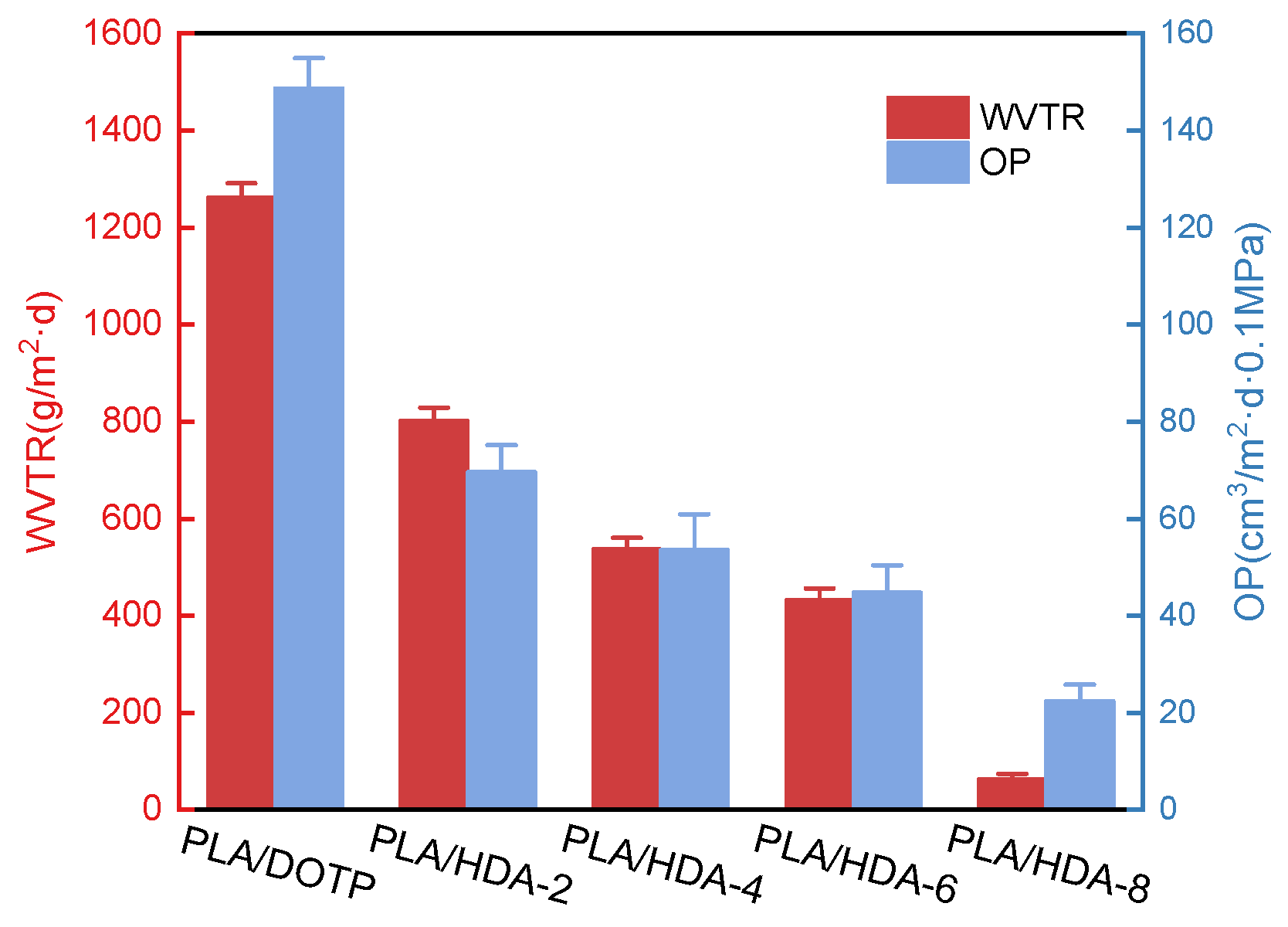
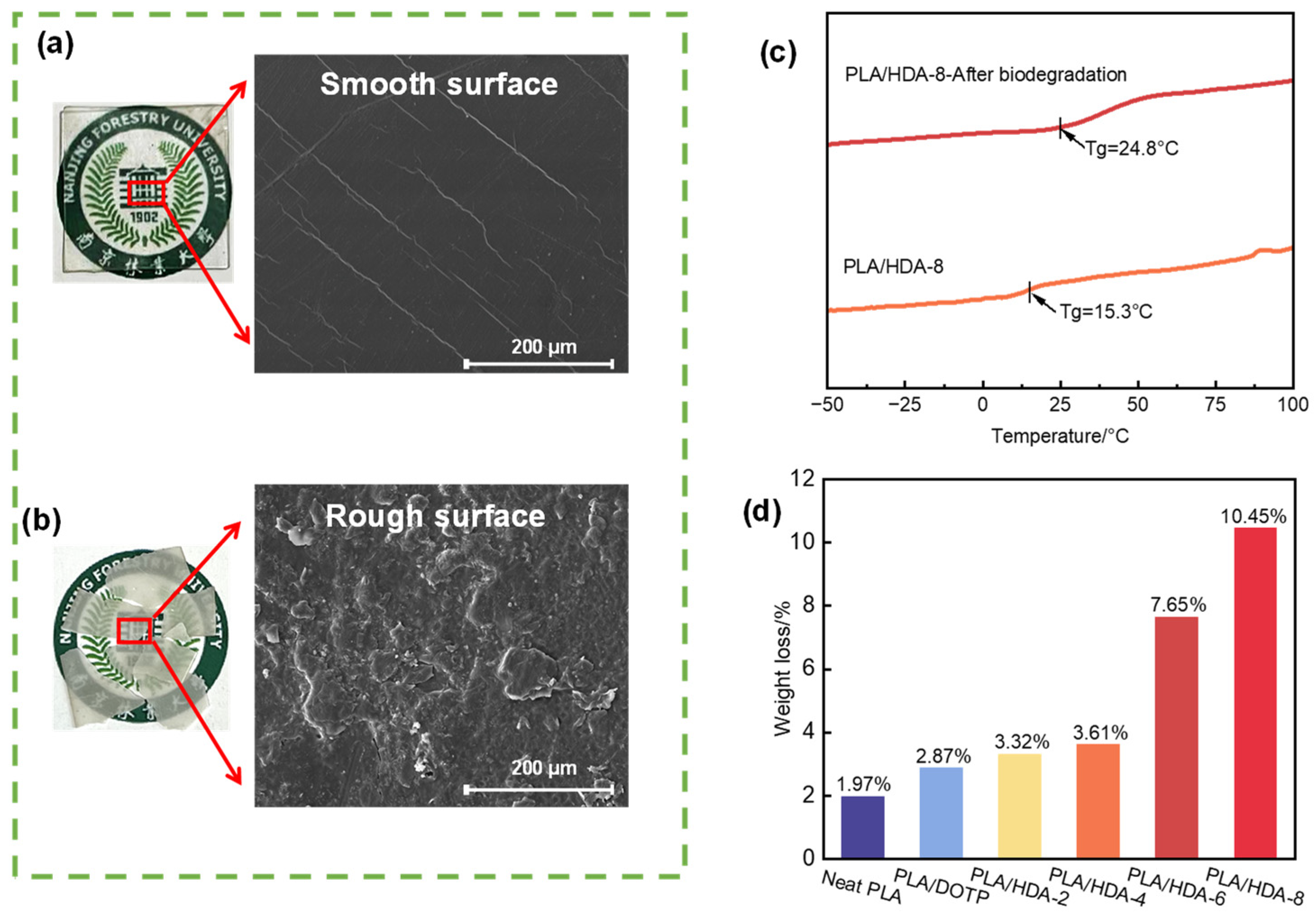
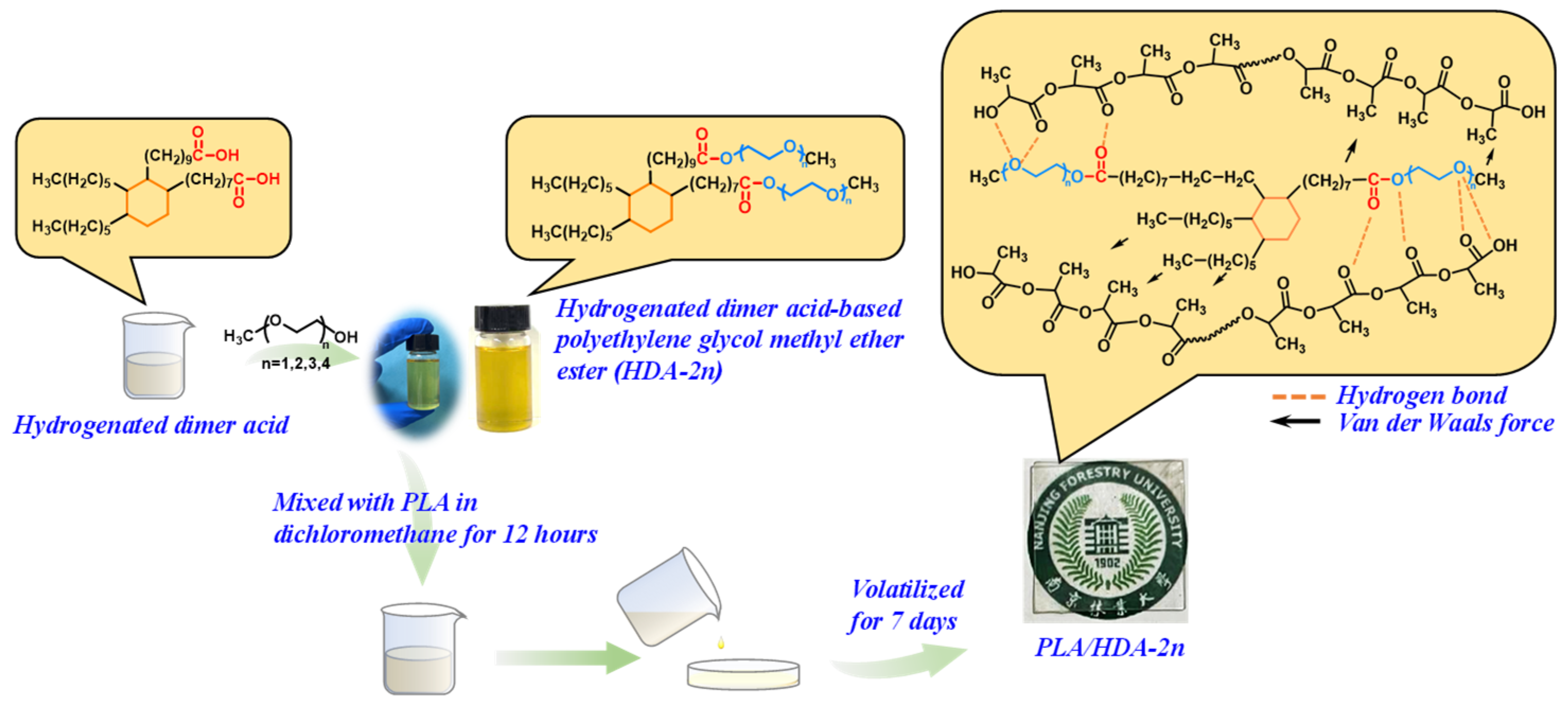
| Plasticizer | Elongation at Break (%) | Tg (°C) | Reference |
|---|---|---|---|
| Epoxidized palm oil (EPO) | 88 | 62.7 | Chieng et al. [27] |
| Dipropyl maleate (DPM) | 200 | 5.0 | Enumo et al. [28] |
| Isosorbide dioctoate (SDO) | 281 | 32.5 | Yang et al. [29] |
| Biosourced glycerol plasticizer (GS-C4-20) | 435 | 24.0 | Halloran et al. [30] |
| Acetylated malic acid alkyl esters (AcMAE-C6) | 567 | 28.8 | Park et al. [31] |
| This work (HDA-8) | 598 | 15.3 | - |
Disclaimer/Publisher’s Note: The statements, opinions and data contained in all publications are solely those of the individual author(s) and contributor(s) and not of MDPI and/or the editor(s). MDPI and/or the editor(s) disclaim responsibility for any injury to people or property resulting from any ideas, methods, instructions or products referred to in the content. |
© 2024 by the authors. Licensee MDPI, Basel, Switzerland. This article is an open access article distributed under the terms and conditions of the Creative Commons Attribution (CC BY) license (https://creativecommons.org/licenses/by/4.0/).
Share and Cite
Huang, N.; Wang, F.; Zhang, R.; Cao, Z.; Sun, W.; Ma, Y.; Tan, J.; Zhu, X. Biodegradable Hydrogenated Dimer Acid-Based Plasticizers for PLA with Excellent Plasticization, Thermal Stability and Gas Resistance. Molecules 2024, 29, 2526. https://doi.org/10.3390/molecules29112526
Huang N, Wang F, Zhang R, Cao Z, Sun W, Ma Y, Tan J, Zhu X. Biodegradable Hydrogenated Dimer Acid-Based Plasticizers for PLA with Excellent Plasticization, Thermal Stability and Gas Resistance. Molecules. 2024; 29(11):2526. https://doi.org/10.3390/molecules29112526
Chicago/Turabian StyleHuang, Nengkun, Fan Wang, Ruihao Zhang, Zhaolin Cao, Wen Sun, Yuting Ma, Jihuai Tan, and Xinbao Zhu. 2024. "Biodegradable Hydrogenated Dimer Acid-Based Plasticizers for PLA with Excellent Plasticization, Thermal Stability and Gas Resistance" Molecules 29, no. 11: 2526. https://doi.org/10.3390/molecules29112526






